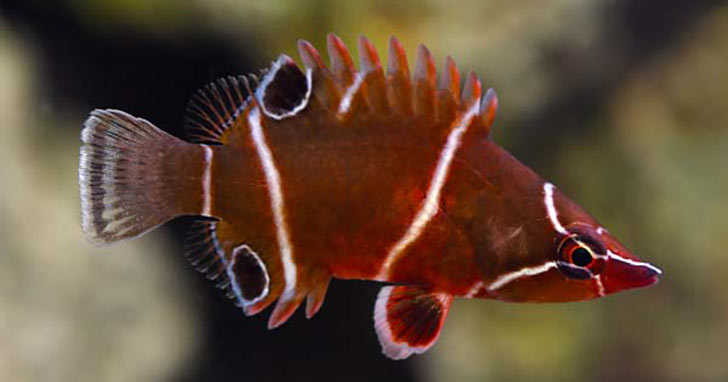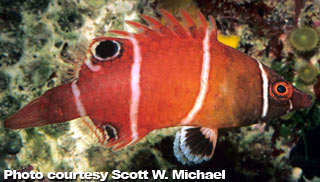The Best Reef Wrasses; Part 6
By Scott W. Michael These wrasses are known commonly as the possum, pygmy or sharpnosed wrasses. The three species are the Whitebanded Possum Wrasse (Wetmorella albofasciata), Yellowbanded Possum Wrasse (W. nigropinnata), and the Pygmy Possum Wrasse (W. triocellata). Of these three species, I have found the Whitebanded and Yellowbanded to be most common in the aquarium trade. Make sure you do not mistake the juvenile of the Slingjaw Wrasse (Epibulus insidiator) for the young W. albofasciata (the young slingjaw and this possum wrasse are very similar). The slingjaw wrasse gets approximately 14 inches in length and is a voracious predator! Relatively little is known about the biology of these wrasses. All three species are quite secretive, spending their days moving within crevices and from hole to hole under overhangs and in caves. They are some of the smallest of the wrasses, reaching maximum lengths of 2.5 inches. These labrids get around in a different manner than most of their kin. They seem to hover, float and skulk about more than others in the family. Adult Wetmorella wrasses are typically found in pairs or in groups. There is no data available on the food habits of these fishes. I assume that they eat small crustaceans, polychaetes worms and possibly foraminiferans (shelled protozoa) and tiny snails (e.g., prosobranch gastropods). (These assumptions are based on data available on the diets of similar sized, secretive wrasses.) Because of their diminutive sizes, the possum wrasses can be kept in small to very large tanks. It is possible to keep a possum wrasse in a nano-reef tank, but you will need to feed them frequently as there will not be enough natural fodder in a small tank to sustain them (more on this later). They can be kept in a large reef aquarium as well, although you may not see them that frequently in a big tank with loads of live rock.
The possum wrasses are more likely to spend time in the open if kept in relatively quite surroundings. Unlike some wrasses, the Wetmorella spp. do not bury in the sand at night. They simply "hole up" in the reef. Not only are they shy by nature, they are also potential targets of tank bullies. It is best to avoid keeping them with more pugnacious species that may pick on them or with fishes that will prevent them from getting enough to eat. That said, I have noticed that many fish simply ignore them. This may be due to their odd behavior, the small size, and somewhat divergent body shape of the possum wrasses. I have never seen these fishes behave aggressively toward other fishes. If you plan on keeping more than one individual of the same species or even congeners in the same tank, make sure the tank is large enough (e.g., 70 gallons or larger) and that it is replete with places for them to hide. Small holes are fine, but they really seem to appreciate caves and ledges. When there are aggression problems, the largest Wetmorella in the tank is likely to be the bully, no matter what species it is. These microcarnivores will feed on tiny worms and crustaceans that associate with live rock. They also readily take aquarium foods, like mysid shrimp, frozen preparations and flake food. Even though they will eat introduced fodder, I think it is still best to house them in a tank with live substrate because they are so reclusive (especially when first added to a tank) and prone to being dominated by tankmates. This will enable the possum wrasses to feed throughout the day on the minute prey living on the rock. A productive refugium can also be helpful to ensure that they get enough to eat. Although they are not bullet proof, I have never had a Wetmorella succumb to a parasitic infection. I believe the most likely cause of death would be malnutrition resulting from infrequent feeding and a impoverished microinvertebrate population in their tank. They might also be intimidated, and thus not get enough to eat, if their tankmates are too boisterous at feeding time. Another possum wrasse problem is shipping stress. Although I have not had that many of these fishes shipped to me at this point, I think they are prone to succumbing to shipping stress. While there are other wrasses that will acclimate to life in captivity, I have found that these groups are durable and better-suited to living with invertebrate tankmates than many others in the family. Happy fish-watching!
Scott Michael Scott W. Michael is an internationally-recognized writer, underwater photographer, and marine biology researcher specializing in reef fishes, and was the Banquet Speaker at our 2007 and 2008 Coral Conference and Frag Swap. He is a regular contributor to Aquarium Fish Magazine, Freshwater and Marine Aquarium Magazine, SeaScope, and is the author of Reef Fishes Vol 1, Vol 2, and Vol 3, Vol 4, and Vol 5., A Pocket Expert Guide Marine Fishes, A Pocket Expert Guide to Reef Aquarium Fishes, 101 Best Saltwater Fishes: How to Choose and Keep Hardy, Brilliant, Fascinating Species That Will Thrive in Your Home Aquarium, Reef Sharks & Rays of the World, and Aquarium Sharks & Rays. Having studied marine biology at the University of Nebraska, Scott has served as a scientific consultant for National Geographic Explorer, the Discovery Channel, and French educational television. |
|||||||||||
|
|



 The major Wetmorella drawback is that they are quite reclusive. They spend most of their time moving among the rock work. Occasionally you will see them peeking out of a crevice or a cave or they may dash out to grab a passing morsel (OK, maybe not dash as they do not swim that fast). While these wrasses are not likely to parade around the tank, they will become more bold once they have acclimated and if they are not picked on by piscine neighbors.
The major Wetmorella drawback is that they are quite reclusive. They spend most of their time moving among the rock work. Occasionally you will see them peeking out of a crevice or a cave or they may dash out to grab a passing morsel (OK, maybe not dash as they do not swim that fast). While these wrasses are not likely to parade around the tank, they will become more bold once they have acclimated and if they are not picked on by piscine neighbors.


